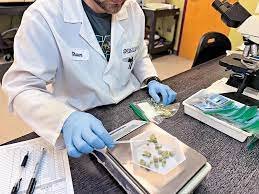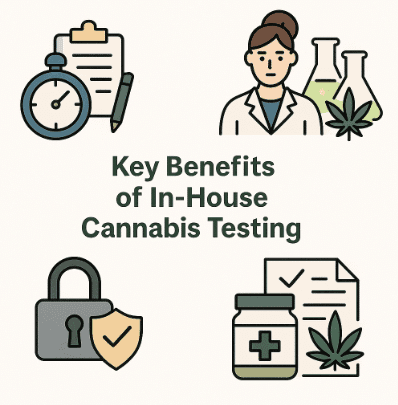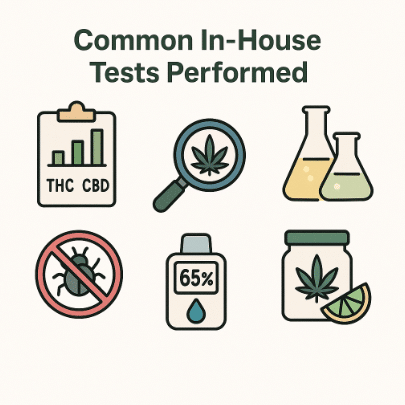With the unprecedented growth of the cannabis industry, there is a need for quality assurance and compliance. Processing labs are facing increasing pressure to ensure product quality, safety, and regulatory compliance. Most cannabis processing labs have adopted in-house cannabis testing, a paradigm shift from traditional third-party laboratory dependencies.
To help you decide on in-house cannabis testing, this guide will explore major considerations, including initial investment costs, technical expertise requirements, regulatory compliance obligations, and long-term operational benefits.
Sections
ToggleWhy In-House Testing Matters in Cannabis Processing Labs

Introducing in-house cannabis testing can equip processing labs with critical quality control data, enabling real-time decision-making during production processes. Proactive testing can help manufacturers identify and address potential issues before they impact product quality or compliance status.
Key Benefits of In-House Cannabis Testing

In-house cannabis testing improves product quality and user experience in several ways:
- Faster Turnaround Times
When processing labs depend on third-party laboratories, they may need to wait several days or weeks to receive test results. With in-house cannabis testing, there is a dramatic reduction in turnaround times for analytical results.
- Greater Control Over Testing Protocols
Processing labs can customize in-house testing protocols to meet their specific operational needs and quality standards. This helps them overcome the limitations of standard third-party lab analysis to implement more frequent testing schedules and develop specialized testing methods for unique products.
- Confidentiality & Data Security
Manufacturers can better protect their proprietary information regarding their products. In-house cannabis testing lets processing labs control their analytical data completely and protect formulation secrets, production methods, and competitive intelligence.
- Regulatory Preparedness
Processing labs can ensure continuous compliance monitoring with in-house cannabis testing. By conducting pre-compliance testing, they can ensure products meet all regulatory requirements before final release.
Common In-House Tests Performed

With a myriad of testing protocols, here are the common in-house cannabis tests performed:
- Cannabinoid Potency Testing
The most widely implemented cannabinoid potency test measures the concentration of key compounds, including THC, CBD, and other cannabinoids.
- Terpene Profiling
Terpene analysis identifies and quantifies the aromatic compounds in cannabis plants. Profiling terpenes helps manufacturers maintain consistent flavor and effects.
- Residual Solvent Analysis
A critical safety test, residual solvent analysis, detects potentially harmful solvent residues from extraction processes. It is essential to ensure safety standards and regulatory limits for consumer protection.
- Pesticide Screening
In-house cannabis testing also includes comprehensive pesticide testing. It enables rapid detection and response to pesticide contamination issues.
- Moisture Content and Water Activity
These tests assess product stability and shelf life by measuring water content and microbial growth potential.
Lab Tools and Equipment Required
In-house cannabis testing requires specialized equipment that ensures the accuracy of analytical data for compliance.
- HPLC (High-Performance Liquid Chromatography):
HPLC systems are a highly efficient analytical platform for cannabinoid potency testing. The setup requires dedicated bench space with vibration isolation, proper ventilation for solvent vapors, and integrated solvent waste management systems. - GC-MS (Gas Chromatography–Mass Spectrometry): GC-MS instruments are essential for terpene profiling and residual solvent analysis. The setup uses inert gases like helium for high sensitivity and compound identification capabilities.
- Moisture Analyzers and Water Activity Meters: These are specialized instruments offering rapid moisture content and water activity measurements. They are critical for product stability assessment in in-house cannabis testing.
- PCR Systems: PCR equipment enables molecular-level testing for microbial contamination and genetic analysis. The setup requires dedicated contamination-free zones with separate sample preparation areas and precise temperature control systems.
Infrastructure Requirements for In-House Testing
To ensure your in-house testing protocols are reliable, you must also ensure infrastructure readiness.
- Cleanroom Design
The lab for testing cannabis must have a proper cleanroom setup. It ensures contamination-free testing environments essential for accurate cannabis testing results. - Utilities Investment
Adequate electrical, HVAC, and water systems support can be needed for specialized equipment requirements of in-house cannabis testing laboratories. - Regulatory Licensing
For operating an in-house cannabis testing lab, appropriate licenses and certifications are required in compliance with local and state regulations.
Budget Considerations

Setting up an in-house cannabis testing lab is a costly affair, requiring proper planning and cost evaluation.
1. Initial Investment
An in-house cannabis testing facility can cost from $200,000 to $500,000, depending on testing scope and equipment selection. You must invest in analytical instruments, infrastructure modifications, and initial staff training.
2. Ongoing Costs
To ensure accuracy and compliance, you must maintain a testing lab, including equipment maintenance, consumables, staff salaries, and regulatory compliance costs. It can require an additional $100,000 to $250,000 annually.
3. Long-Term ROI
Most in-house cannabis testing operations achieve positive investment returns within 2-3 years. You reduce third-party testing costs and improve operational efficiency in the long run.
Quality Assurance in In-House Settings
To ensure your in-house cannabis testing has the same credibility as third-party lab tests, you have to implement a robust quality assurance protocol.
Creating internal standards that match or exceed regulatory benchmarks. It involves implementing comprehensive documentation systems, regular equipment calibration schedules, and staff training protocols to maintain testing accuracy and reliability.
Using blind sampling and routine verification to avoid bias. This approach ensures objective results through regular participation in proficiency testing programs and cross-validation with accredited third-party laboratories.
Implementing SOPs and regular audit forms the foundation of reliable in-house cannabis testing programs. These systems ensure consistent testing protocols, proper documentation practices, and continuous improvement in analytical capabilities.
Challenges of In-house Cannabis Testing
Setting up an in-house cannabis testing facility can present several challenges.
1. High Upfront Costs
Setting up a proficient and effective testing lab requires significant initial investment, presenting financial challenges for smaller processing operations.
2. Technical Expertise
Successful in-house cannabis testing requires specialized technical knowledge and ongoing staff training to maintain analytical competency.
3. Regulatory Oversight
To operate a compliant in-house cannabis testing facility, manufacturers must navigate complex regulatory requirements.
Is In-House Testing Right for Your Lab?
We recommend setting up an in-house cannabis testing lab if:
- You process high volumes of cannabis, requiring frequent testing.
- Your operation can support the initial investment and ongoing operational costs effectively.
- Your production facility has adequate space and infrastructure to support in-house cannabis testing operations.
- You have staff with technical expertise to operate and maintain analytical equipment reliably.
Conclusion
In-house cannabis testing is a strategic step offering significant operational advantages for processing facilities. However, the initial costs and complexity can present challenges. But if your operations are large-scale, you benefit from in-house testing in the long term as improved efficiency, enhanced quality control, and regulatory preparedness give you a competitive edge.



